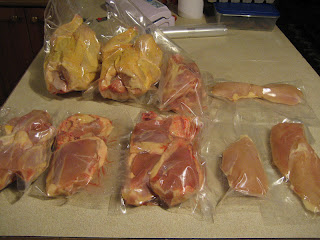Just to refresh here are the facts.
We started off with 14, week old, commercial meat chicks ($30) and a 20kg bag of chick starter ($18).
They grew very quickly and right from the start there were some that were much bigger that others. Sadly 2 chicks died early on, we are pretty sure they got too cold which is always a potential issue with chicks.
All they did was eat and poop and they did a lot of both. They grew very quickly and were fully feathered in 2 weeks. It was becoming obvious why they were used by commercial growers. We purchased a second bag of chick starter when the chicks were 4 weeks old. The chicks end up pooping into their food so you loose a bit just trying to keep their food clean.
 |
| Check out the size difference. |
Although we planned to keep ours a few weeks longer than the standard 7 weeks that commercial farms farms finish at, they really were ready to go.
As they got older they started to act and look more like chickens, albeit very chunky chickens. They had access to grass and clucker tucker at all times and they loved to just lie in the sun and eat.
We then purchased a bag of broiler finisher ($19) to get the chickens to the butchering stage. I investigated a number of different food options because I was really not sure what was different about the broiler finisher compared to the grain or layers mask we buy for our laying hens. I discovered that the broiler finisher ($19) was 22% protein compared to15% for layers mash ($14) and 11% for mixed grain ($11). As it got towards the end we decided not to spend the extra money on a second bag of finisher so instead we did a 50/50 mix of grain and finisher for the last week and a half. The back of the bag advised the broiler finisher should not be fed to laying hens and I was a bit puzzled at the time but now I have a theory.
You see when we butchered the first chicken it was 7 weeks old an weighed in at 1.3 kg and the meat did not have any more fat that a store brought bird. The next 6 that we butchered a week later were definitely bigger and weighed in at an average of 1.7kg. They also had a fat deposits on different parts of their bodies (across the breast and back) and a bit of fat under the skin around their rear end/cloaca. The last 5 that we killed 2 weeks after the first were heavy weights. They averaged 1.95kg and the 2 heaviest weighed in at 2.2 kg and 2.3 kg dressed weight (plucked, gutted and ready to cook). Not only were they that much heavier but they were fat. They had fat in all the same places at the 6 the week before but there was more of it and it was surrounding their organs and thick around their rear ends. This is why I think there is a warning not too feed the broiler food to layers. I know that if laying hens get too fat they have trouble laying so the higher protein food could really cause issues.
 |
| The heavy weights from the last batch |
All of the chicken has now been portioned out and packed away and we are looking forward to home grown meals ahead.
The conclusion that we have come to is that we will no be purchasing some Light Sussex eggs and repeating the process so that we have a even playing field to compare the two methods. Using the Light Sussex will take longer but we will not have to buy the chicks or be stuck to a very tight time schedule for when we have to kill the chickens like you have to with the commercial breeds.But that is another story and for another day.



















0 comments:
Post a Comment